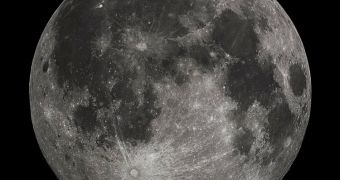In a discovery that raises a lot of new questions on the mechanisms and processes that led to the formation of the Moon, researchers identified telltale signs on the surface of Earth's natural satellite indicating that it may have been geologically active as recently as 50 million years ago.
According to the models experts use to describe the Moon's existence today, this shouldn't have happened. The Moon is believed to have been formed when an object the size of Mars collided with Earth, shortly after the original planets accreted from the Sun's protoplanetary disk.
The impact is thought to have been so powerful that it ripped a large chunk of the former worlds. The debris eventually coalesced into the Moon, and solidified later on. But geological and tectonic activities on the satellite should have discontinued about a billion years ago.
Yet, close-up observations of a series of lunar highlands demonstrate that they were produced by a wrinkling process affecting the surface of the Moon. Such a phenomenon could have occurred only as the lunar core cooled and became smaller.
The age of these landscape features has been estimated to be roughly 50 million years, a finding that presents scientist with a dilemma. The data were derived from images collected by the Lunar Reconnaissance Orbiter (MRO).
The orbiter was able to identify a series of graben on the lunar surface, both in the highlands and on a number of plains made out of dark, volcanic ash. These features are narrow features similar to trenches. On the Moon, they are thought to have formed as the crust expanded and stretched.
“Overall on the Moon, you have this contracting, shrinking environment, but in some places, apparently there's this stretching extension of the crust,” explains planetary scientist and lead study author Thomas Watters, who is based at the Smithsonian Institution in Washington.
What captured experts' eyes about these particular features is the fact that they appear to be in perfect condition. Their edges are not yet eroded, and they exhibit no poke marks as a result of cosmic collisions with meteorites or asteroids.
Even more remarkable, the team cannot say for certain how young these landscape features are. “We think they're less than 50 million years old, but they could be 10 million years old, could be 1 million years old, could have happened 40 years ago,” Watters adds.
“The intriguing picture that's emerging of the moon is that there is recent geological activity going on,” he concludes, quoted by Space. Details of the investigation were published in the February 19 issue of the top journal Nature Geoscience.

 14 DAY TRIAL //
14 DAY TRIAL //